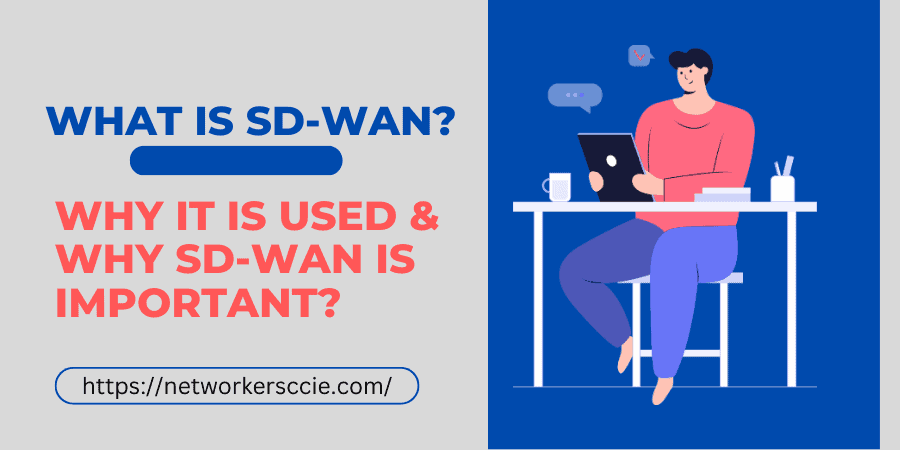SD-WAN can optimize and increase the peformance of wide area networks (WAN) by using SDN technology. It helps to reduce costs, improve application performance, optimize user experience and efficiency, by automation and cloud based management it simplify operations. Not only in 2023 but in upcoming years also it is expected that SD-WAN will continue to gain in acceptance as more businesses use the technology to boost the efficiency and security of their WANs.
Let’s discuss in detail with table of contents.
Table of contents
- What is SD-WAN?
- What is Cisco viptela SD-WAN?
- Why SD-WAN Viptela?
- How does SD-WAN works?
- Why network engineers should learn SD-WAN?
- Is there good scope in career after learning SD-WAN?
- Who should learn SD-WAN?
1. What is SD-WAN?
SD-WAN means software-defined wide-area network. SD-WAN is used by thousands of companies across all over the globe to connect their branches to a wireless network. It is used to connect business networks, such as remote locations and branch offices, to a main network or the internet. Because SD-WAN offers finer-grained control over traffic routing and prioritisation, network resources can be used more effectively, leading to better network performance. In order to increase dependability and cut costs, it also facilitates the use of various WAN connections, such as broadband and cellular.
2. What is Cisco viptela SD-WAN?
Software-defined wide area network (SD-WAN) solution developed by Cisco Systems is called Cisco Viptela SD-WAN. It is a cloud-delivered technology that makes it possible for business networks to be more cost-efficient, secure, and agile. Viptela SD-WAN automates the deployment and management of WAN connections, enabling clients to streamline branch office networking and enhance application performance. In order to provide more dependable and economical WAN access, it can also leverage numerous internet connections. End-to-end network segmentation, secure access, and enhanced threat protection are also offered by Viptela SD-WAN. It is interoperable with other Cisco SDN products and made to operate with current network infrastructure.
3. Why SD-WAN Viptela?
There are several reasons why an organization may choose to use Cisco Viptela SD-WAN over other solutions:
- Network management made easier: Viptela SD-WAN offers a user-friendly, cloud-based management platform that makes it easier to build and maintain WAN connections.
- Improved application performance: Viptela SD-WAN uses sophisticated traffic management algorithms to make sure that business-critical apps are given precedence over less important traffic, improving overall performance and enhancing application performance.
- Cost Savings: Viptela SD-WAN can deliver more dependable and cost-effective WAN connectivity by utilising various internet connections, including broadband and cellular.
- Flexibility: Viptela SD-WAN is flexible to various network environments since it can be installed on a variety of hardware platforms, including routers, gateways, and virtual appliances.
- Security: To safeguard the network from cyber attacks, Viptela SD-WAN offers end-to-end network segmentation, secure access, and enhanced threat protection.
- Scalability: Viptela SD-WAN can quickly expand to support thousands of sites in order to meet the needs of your corporation.
- Integration: Viptela SD-WAN is simple to integrate with your current network because it is made to work with existing network infrastructure and is compatible with other Cisco SDN solutions.
4. How does SD-WAN works?
SD-WAN (Software-Defined Wide Area Network) works by using software to manage and optimize the performance of a wide area network (WAN). The key components of an SD-WAN system include:
- SD-WAN controller is a central management system responsible for configure and manage all of the devices on the SD-WAN networks. Based on variables including bandwidth, latency, and packet loss, the controller utilises algorithms to choose the best path for data.
- SD-WAN devices such as routers or gateways, that are deployed at each location on the WAN. They use the policies and configuration set by the controller to direct traffic over the best path.
- SD-WAN devices use multiple WAN connections, such as broadband, cellular, and MPLS, to provide more reliable, and cost-effective WAN connectivity.
- SD-WAN devices use tunneling protocols to create secure, encrypted connections between sites.
- SD-WAN uses QoS policies to prioritize different types of traffic, such as business-critical applications, to ensure that they receive the necessary bandwidth and low latency.
The SD-WAN device at that branch office will utilise the policies and configurations established by the controller to choose the appropriate path for the traffic when a user at that branch office opens a session or application. The device will then reroute the traffic via that route, encrypting and securing it utilising the WAN connections at the location and tunnelling protocols. Additionally, the SD-WAN device will apply QoS settings to prioritise various traffic types as necessary.
5. Why network engineers should learn SD-WAN?
There are several reasons why network engineers should learn SD-WAN (Software-Defined Wide Area Network):
- Demand for network engineers with SD-WAN experience is projected to rise as more enterprises adopt SD-WAN to boost the performance and dependability of their WANs.
- Network engineers’ jobs may be made easier by SD-WAN, which offers a more centralised and automated method to managing WAN connections.
- Application performance is enhanced because to the deployment of advanced traffic management strategies by SD-WAN, which give business-critical apps priority over less important traffic to enhance overall performance and user experience.
- SD-WAN can deliver more dependable and cost-effective WAN connectivity by utilising various internet connections, including broadband and cellular.
- SD-WAN is adaptable to many network environments since it can be installed on a variety of hardware platforms, including routers, gateways, and virtual appliances.
- To defend the network from cyber attacks, SD-WAN offers end-to-end network segmentation, secure access, and enhanced threat protection.
- SD-WAN may quickly expand to handle thousands of sites in order to meet the needs of your corporation.
- SD-WAN is simple to connect with your current network because it is made to work with existing network infrastructure and is compatible with other SDN systems.
Overall, becoming more knowledgeable about SD-WAN can help network engineers perform their jobs more effectively and efficiently while also better preparing them to adapt to the changing needs of their organisations.
6. Is there good scope in career after learning SD-WAN?
There is good scope for a career in SD-WAN (Software-Defined Wide Area Network) as more and more organizations are adopting this technology to improve the performance and reliability of their WANs. This creates a high demand for professionals with expertise in SD-WAN.
Some of the job roles that may be available for individuals with SD-WAN knowledge include:
- SD-WAN Engineer: This role involves designing, deploying and maintaining SD-WAN networks.
- Network Engineer: SD-WAN knowledge can help network engineers become more efficient and effective in their roles, and better equipped to meet the changing needs of their organizations.
- Network Administrator: Responsible for the day-to-day operation and maintenance of SD-WAN networks.
- Network Architect: This role involves designing and planning SD-WAN networks to meet the needs of the organization.
- Network Consultant: Advising organizations on the best way to implement SD-WAN and providing guidance on the design and deployment of SD-WAN networks.
- Network Manager: Responsible for managing and overseeing the SD-WAN network and ensuring that it meets the needs of the organization.
Overall, with the growing adoption of SD-WAN technology, there is a high demand for professionals with SD-WAN expertise. This creates good career opportunities for those who are interested in this field.
7. Who should learn SD-WAN?
Consider learning about SD-WAN if you’re interested in networking and want to keep up with the newest innovations and technology (Software-Defined Wide Area Network). People in the following categories would profit from learning more about SD-WAN:
- Network Engineers: Network engineers are responsible for designing, deploying and maintaining networks. Understanding SD-WAN can help them to improve the performance and reliability of WANs and make their job easier.
- Network Administrators: Network maintenance and daily operation are the responsibility of network administrators. Their work will be made simpler and WAN performance and reliability will be improved thanks to SD-WAN.
- Network Architects: Network architects are responsible for designing and planning networks to meet the needs of the organization. Understanding SD-WAN can help them to design networks that are more agile, secure and cost-effective.
- IT Professionals: IT professionals who want to stay current with the latest technologies and trends should consider learning about SD-WAN.
- Network Consultants: Network consultants advise organizations on the best way to implement new technologies such as SD-WAN and provide guidance on the design and deployment of SD-WAN networks.
- Network Managers: Network managers are responsible for managing and overseeing the network and ensuring that it meets the needs of the organization. Understanding SD-WAN can help them to improve the performance and reliability of WANs and make their job easier.
In conclusion, knowing about SD-WAN is something that anyone with an interest in networking who wants to keep up with current technology and developments should think about doing.



